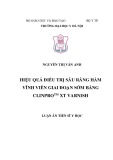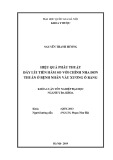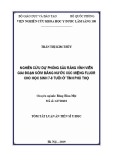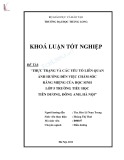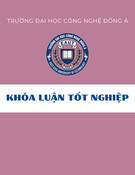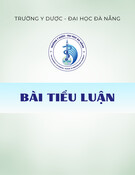
MINISTRY OF EDUCATION AND TRAINING MINISTRY OF DEFENCE
108 INSTITUTE OF CLINICAL MEDICAL AND PHARMACEUTICAL SCIENCES
-------------------------------------------------
TRAN THI KIM THUY
RESEARCH ON THE PREVENTION OF INCIPIENT CARIES
WITH FLUORIDE ORAL RINSING SOLUTION FOR 7-8
YEAR-OLD PUPILS IN PHU THO PROVINCE
Speciality: Odonto Stomatology
Code: 62720601
ABSTRACT OF MEDICAL PHD THESIS
Hanoi – 2019

THE THESIS WAS DONE IN: 108 INSTITUTE OF CLINICAL
MEDICAL AND PHARMACEUTICAL SCIENCES
Supervisor:
1. Prof. PhD. Trinh Dinh Hai
2. Ass. Prof. PhD. Le Thi Thu Ha
Reviewer 1:
Reviewer 2:
Reviewer 3:
This thesis will be presented at Institute Council at: 108 Institute of
Clinical Medical and Pharmaceutical Sciences
Day Month Year
The thesis can be found at:
1. National Library of Vietnam
2. Library of 108 Institute of Clinical Medical and
Pharmaceutical Sciences

1
A- THESIS INTRODUCTION
RESEARCH STATEMENT
Dental caries has worldwide, and besides periodontal disease, been
considered as one of the two leading burdens for dental healthcare.
According to the WHO (World Health Organisation) oral and dental
healthcare report in 2003, dental caries has presented impact on 60-90%
pupils, and almost adults, in a big number ofindustrial countries, with
the highest incidence in some Asian and Latin America countries. In
Vietnam, the incidence has been maintained at a high level, and tended to
increase, especially in rural and mountainous areas.
The role of fluoride, in general,and of fluoride oral rinsing solution,
in particular, has been known and recognized as a means toreduce
incidence and seriousness of dental caries. A research by Marinho et al.
(2003), through a general analysis of intervention research, indicates that
fluoride0.05% oral rinsing solutionreduces 45% dental caries rate
(95%CI: 0.35 - 0.50). These studies, however, have many limitations
such as not providing an optimal using method (with high efficiency,
safety, and convenience) or suggestingan optimal dosage for each stage
of dental caries.
In Vietnam, there are many dental caries researches conducted
covering all ages of the population, but most of them have been confined
in possibility of advanced-stage dental caries diagnosis. Therefore
efficiency in prevention and treatment are still low. There have not been
many studies on early childhood caries in children as well the use of
0.05% fluorideoral rinsing solution in prevention and treatment from
these stages. The research "Research on the prevention of incipient caries
with fluorideoral rinsing solution for 7-8-year-old pupils in Phu Tho
province" has two goals:
1. Determine icipient caries in permanenr teeth and related factors
in 7-8 year old pupils at Dinh Tien Hoang and Tan Dan schools
in Phu Tho, 2015.
2. Assess the efficiency of prevention and treatment of incipient
caries in permanent teeth by the use of 0.05% fluorideoral
rinsing solution on pupils 7-8 years after 18 months.

2
THE URGENCY OF THE RESEARCH
The understanding of dental carious pathotogy, especially during
early stages, has been neglected to some extent. Elements relating to
dental caries, methods of detection, diagnosis and prevention by
fluorideoral rinsing solution to maintain permanent healthy teeth is
essential.
Establishing a proper plans for preventing and treatment dental
caries during the early stage of permanent teeth eruption, many updated
data as well the specific efficiency of 0.05% fluorideoral rinsing solution
on carious lesions are need to be studied.
PRACTICAL MEANING AND NEW CONTRIBUTIONS
1) Update the incidence of incipient caries in permanent teeth and
detect some factors related to dental caries in 7-8 year old pupils.
2) Effectiveness of 0.05% fluorideoral rinsing solution in
prevention and treatment to demineralization incipient caries in
permanent teeth (D1, D2) is very high.
3) Changing diagnosis criteria according to ICDAS system will help
managers with giving more effective methods to prevent dental caries.
4) A simple, safe and low cost fluorideoral rinsing solution
programme should be planned during primary school.
THESIS STRUCTURE
The thesis consists of 4 chapters: Chapter I: Overview, 35 pages.
Chapter II: subjects and research methods 25 pages. Chapter III Research
results 36 pages.Chapter IV: 35 pages discussion. The thesis has 35
tables, 03 diagrams, 08 charts, 23 figures, 111 references, (27 in
Vietnamese, and 84 in English)
B. THESIS CONTENT
CHAPTER 1. AN OVERVIEW
1.1. Characteristics of primary dentition, permanent dentition and
pediatric oral pathology
1.1.1. Characteristics of teeth and permanent teeth: There are 4 stages.
From Embryonic stage to 3 years old: fully erupted primary teeth.
From 3-6 years old stage: primary dentition
From 6-12 years old: mixed dentition
From 12-18 years old: permanent dentition

3
1.1.2. Microscopic characteristics of tooth enamel:
In children, the distance between the enamel prism is big because
the calcification stage has not finished, whereas in adults, the
mineralization process is completed, it is impossible to find the space.
1.1.3. Characteristics of pediatric oral pathology
The typical dental diseases in children are related closely to diet,
oral hygiene and oral prophylaxis.
1.2. Understandings about dental caries and early stage dental caries
1.2.1. Definitions of dental caries:
- Caries is infection of the hard tissue of the teeth, characterized by
demineralization of inorganic components and destruction of organic
components.
- Early childhood caries (ECC) in children is the presence of one or
more deep carious lesions (already form into holes or not yet) on any
primary teeth in 71 months old children or younger.
-Incipient caries is a reducing pH process which lead to
demineralization that enhances the distance between hydroxy apatite
crystals, demineralization starts under the enamel surface, clinical carious
lesions is lost 10% of minerals.
1.2.2. Etiology of dental caries
Dental caries is a multifactorial disease
1.2.3. Physiology of dental caries
1.2.4. Progression of carious lesions:
The time for a lesion to progress from incipient caries to clinical
deep hole take several months up to over 2 years, depending on the
balance between demineralization and mineralization.
1.2.5. Classification of dental caries:
Classification by "site and size", by Pitt's diagnostic threshold and
by ICDAS are often applied in scientific research and community.
1.2.6. Diagnosis of dental caries:
There are many methods used to diagnose dental caries, each
methods have different diagnostic threshold and different diagnostic
criteria such as: visual examination, bitewing x-ray, electronic checking
machine (ECM), Fluorescent laser diagnosis (DIAGNODENT), digital
imaging fiber optic transillumination (DIFOTI), Quantitative Light-
induced of fluorescence (QLF), caries detection dyes, digital photos.
1.2.7. Epidemiology of dental caries and early stage dental caries in
children
1.2.7.1. Worldwide: early 21st century, dental caries is still a dental
health problem in most industrialized countries, affecting 60-90% of
pupils and most adults.


